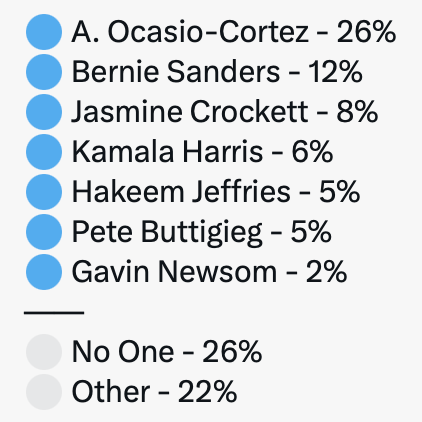Politico is out today with a story on how potential presidential candidates are “saying the quiet part out loud about 2028.” The article cites, in order, a full range of centrists: Buttigieg, Beshear, Shapiro, Rahm, and Raimondo.
But with 998 days until the first Democratic presidential primary, here is how Americans answer “Who is the face of the Democratic Party?”
In “wonder why there aren’t many red district Democrats” news: this week Jared Golden has been both
threatened with a primary challenge from the left by a statewide elected official in Maine, AND
harassed on the street by an NRCC operative on “men competing in women's sports” in a video featured by Daily Caller
Luckily, Golden was mostly obscured in the video by a handsome man in flannel, and his potential challenger looks like one of the recurring quote characters in The Onion:
Reminder: you can donate to Golden on the Win The Middle slate page here.
On a brighter note, voter records reveal some blue smoke: new Pope Leo doesn’t just have harsh words for Trump & Vance, he voted in the 2008 and 2010 Democratic primaries.
Two recommended reads today. First, former Biden policy honcho Stef Feldman’s newsletter is quickly becoming a must-read. And the titles are nice and self-explanatory. Today’s is “A Former Biden Advisor’s Analysis of Why Joe Biden Shifted Left”.
Main takeaway? It was the staffers:
Below are the key factors driving the leftward tilt of the Biden Administration political appointees:
There were fewer people who believed in the Biden approach than there were jobs in the Administration. On average, Democratic staffers are further left than the Democratic base (and Biden).
The transition team and the personnel team in the Administration were staffed with many people further left than Biden and their networks were more progressive.
Left-leaning advocacy organizations had better structures set up to recommend candidates for political appointments.
For a response to this problem, check out Third Way’s Moderate Talent Pipeline.
Second, Phyllis Segal has a stirring piece in The Contrarian on Trump cuts to AmeriCorps:
The DOGE ax fell mid-April on national and community civilian service. Firing vast swaths of the federal workforce, closing programs and cutting grants is now all too familiar. But this story is also about weakening civic participation essential to a thriving democracy. It’s about dismissing unpaid volunteers and AmeriCorps members paid a modest living stipend to help communities throughout the nation.
Tens of thousands of these men and women were abruptly let go in the midst of their service terms. Close to $400 million in grants, awarded to thousands of nonprofit, faith-based and community organizations in over 35,000 locations across the country were cut off without notice. Almost the entire AmeriCorps agency staff was put on administrative leave, and layoff notices were sent beginning on April 24.
You can read the whole thing here.
I am one of the 1.3 million AmeriCorps alums, but it took a decade after my service year to understand its political relevance. A Brookings paper, The Politics of Service: How a Nation Got Behind AmeriCorps, tells the story:
In 1988, Governor (Bill) Clinton had endorsed the Democratic Leadership Council’s landmark report Citizenship and National Service, which called for national service for all who volunteered and proposed that federal college student aid be conditioned on such service. As chair of the National Governors Association, Clinton had formed a working group on national youth service. In the 1992 presidential campaign the idea clicked. Clinton found that his most popular campaign promise was to create a large-scale service corps, offering as a carrot college aid to all who served a year or more in the community.
In What It Took to Fix the Democratic Brand Last Time Around, John Avlon puts the service program into the broader context of addressing the party’s weaknesses:
We shored up Democratic weaknesses on the economy, crime, and national security. We stayed out of day-to-day fights and concentrated on developing big, defining ideas—like national service (AmeriCorps), the earned income tax credit, welfare reform, charter schools, community policing, and reinventing government—that told voters that we were different from the Democrats they had been voting against for a quarter century.
The subhead of Avlon’s piece is “Today’s solutions will be different, but there are lessons worth learning from the story of the Democratic Leadership Council.” We have gotten into those lessons a few times1, and what Americans are voting against is clear:
The DLC’s policy solutions have changed millions of lives. I was lucky to experience two of them firsthand, AmeriCorps and charter schools. That’s the silver lining to today’s political mess: a renewed urgency for bold policies that deliver, and for the cross-sector entrepreneurs required to help fulfill the policy promises that win elections.
Necessity sparks invention, and a community built to invent can endure. Even among those who don’t realize how it started.





